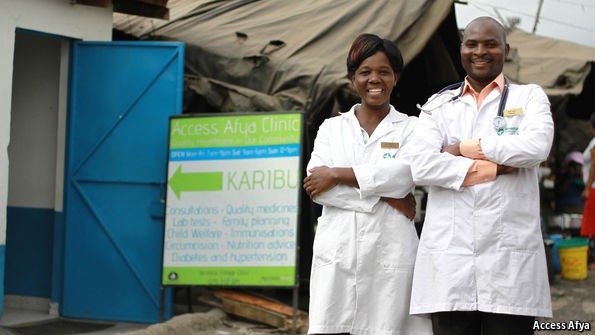WHERE do slum-dwellers go when they fall ill? In Mukuru, a densely packed warren of corrugated iron shacks in south-east Nairobi, the usual answer is to find a backstreet pharmacist. At one of these, customers can buy packets of pills for the ailments caused by living in a tough neighbourhood: antimalarials; antibiotics; aspirin. Drugs are not always reliable: fake or out-of-date medicines are common. A patient who thinks he has malaria when he actually has flu will not be put right by a slum pharmacist.
For the past few years, however, in one corner of Mukuru, people with medical problems have had a better option. Opposite a makeshift public urinal which costs five Kenyan shillings (about 5 cents) to use is a smart green- and white-painted clinic. From 7am until 8pm each day it offers primary health care to anyone who walks in. A price list explains that a consultation is 100 shillings; the various tests and treatments on offer cost a little more. Staff tap patients’ details into an iPad; the shift’s clinician, Ian Oyola, shows off an examination room with scales, blood-pressure monitor and the various other tools of a modern doctor’s surgery.
The clinic is one of two run by Access Afya, an NGO that also provides health care to children in several low-cost private schools in Nairobi’s slums. It illustrates how aid is evolving. Funding is a mix of public and private; smart technology is used to improve efficiency and results—and the aim is as much to show the way for others as to serve immediate needs. Though the NGO gets some money from donors, including Grand Challenges Canada, a Canadian government fund for health-care innovation, and USAID, America’s aid agency, 70% of the clinics’ running costs are covered by patients’ fees, and that share is rising. Melissa Menke, the American founder, plans to open three more clinics in Nairobi next year. But just as important is to create a model for affordable, self-sustaining clinics that can be copied by others across the developing world.
The clinics record patients’ data via a custom-built iPad app that automatically uploads the information to head office, where it can be analysed. A spike in upset tummies might suggest a problem with the local water supply; that in turn could prompt a text message to patients in the affected area warning them to be careful (and perhaps buy water-purification tablets). All patients receive phone calls after consultations to check that the treatment is working. Drugs inventory is managed with commercial retail software, which tracks trends and alerts staff when something is running low.
Patients are mostly drawn from Nairobi’s poorest, making perhaps $50-150 a month running informal businesses in the slum. But a growing minority are slightly better off, working as security guards or in factories. Dommianah Mwikali, one of Access Afya’s community workers, says that many of the best customers are members of local savings and self-help groups. If health care is good, she says, people will pay for it.
